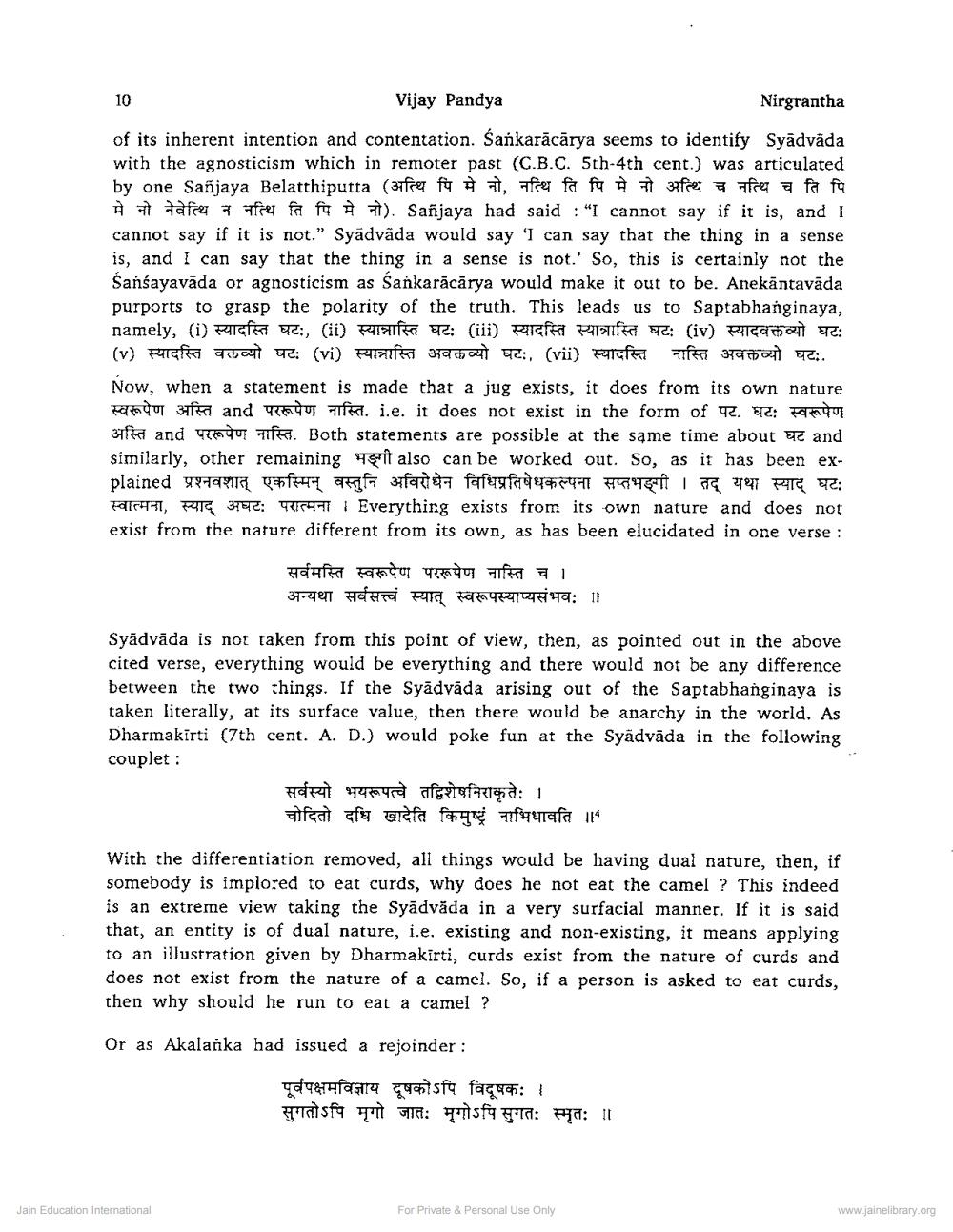Book Title: Refutation of Jain Darshan Author(s): Vijay Pandya Publisher: Z_Nirgrantha_1_022701.pdf and Nirgrantha_2_022702.pdf and Nirgrantha_3_022703.pdf View full book textPage 2
________________ Vijay Pandya Nirgrantha of its inherent intention and contentation. Sańkarācārya seems to identify Syādváda with the agnosticism which in remoter past (C.B.C. 5th-4th cent.) was articulated by one Sanjaya Belatthiputta (अस्थि पि मे नो, नस्थि ति पि मे नो अस्थि च नत्थि च ति पि में नो नेवेत्थि न नत्थि ति पि मे नो). Saijaya had said : "I cannot say if it is, and I cannot say if it is not.” Syādvāda would say 'I can say that the thing in a sense is, and I can say that the thing in a sense is not.' So, this is certainly not the Śansayavāda or agnosticism as Sankarācārya would make it out to be. Anekāntavāda purports to grasp the polarity of the truth. This leads us to Saptabhanginaya, namely, (i) स्यादस्ति घटः, (ii) स्यान्नास्ति घटः (iii) स्यादस्ति स्यान्नास्ति घटः (iv) स्यादवक्तव्यो घट: (v) स्यादस्ति वक्तव्यो घटः (vi) स्यानास्ति अवक्तव्यो घटः, (vii) स्यादस्ति नास्ति अवक्तव्यो घटः. Now, when a statement is made that a jug exists, it does from its own nature स्वरूपेण अस्ति and पररूपेण नास्ति. i.e. it does not exist in the form of पट. घटः स्वरूपेण अस्ति and पररूपेण नास्ति. Both statements are possible at the same time about घट and similarly, other remaining it also can be worked out. So, as it has been explained प्रश्नवशात् एकस्मिन् वस्तुनि अविरोधेन विधिप्रतिषेधकल्पना सप्तभगी । तद् यथा स्याद् घट: स्वात्मना, स्याद् अघटः परात्मना । Everything exists from its own nature and does not exist from the nature different from its own, as has been elucidated in one verse : सर्वमस्ति स्वरूपेण पररूपेण नास्ति च । अन्यथा सर्वसत्त्वं स्यात् स्वरूपस्याप्यसंभवः ॥ Syädvāda is not taken from this point of view, then, as pointed out in the above cited verse, everything would be everything and there would not be any difference between the two things. If the Syādvāda arising out of the Saptabhanginaya is taken literally, at its surface value, then there would be anarchy in the world. As Dharmakirti (7th cent. A. D.) would poke fun at the Syadvada in the following couplet: सर्वस्यो भयरूपत्वे तद्विशेषनिराकृतेः । चोदितो दधि खादेति किमुष्ट्र नाभिधावति ॥4 With the differentiation removed, all things would be having dual nature, then, if somebody is implored to eat curds, why does he not eat the camel ? This indeed is an extreme view taking the Syādvăda in a very surfacial manner. If it is said that, an entity is of dual nature, i.e. existing and non-existing, it means applying to an illustration given by Dharmakirti, curds exist from the nature of curds and does not exist from the nature of a camel. So, if a person is asked to eat curds, then why should he run to eat a camel ? Or as Akalanka had issued a rejoinder: पूर्वपक्षमविज्ञाय दूषकोऽपि विदूषकः । सुगतोऽपि मृगो जातः मृगोऽपि सुगतः स्मृतः ॥ Jain Education International For Private & Personal Use Only www.jainelibrary.orgPage Navigation
1 2 3 4 5 6 7 8
